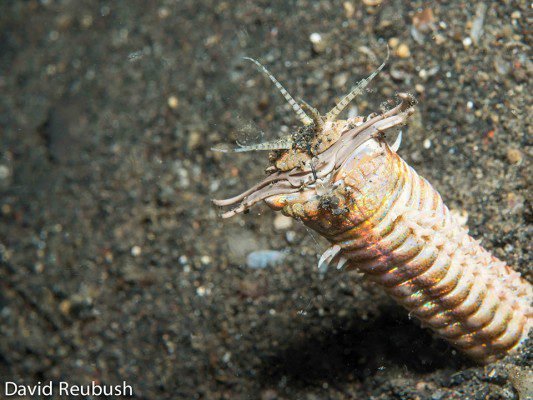
Imagine you’re in a cozy coffee shop, and I’m sharing some juicy tidbits about these amazing worms. You might be wondering why all this matters or how it even works. Regeneration is a big deal in the animal kingdom, and understanding it in creatures like the Bobbit worm gives us insight into biology and evolution. So, grab your coffee, and let’s explore this intriguing topic!
What Are Bobbit Worms?
Bobbit worms, or *Eunice aphroditois*, are fascinating marine creatures often found buried in sandy or muddy substrates in warm waters. You can recognize them by their long, segmented bodies and sharp teeth, which they use to hunt prey. They’re expert ambush predators, staying hidden until unsuspecting fish swim by, then striking like lightning.
These worms can grow anywhere from a few inches to an impressive ten feet long! They have a unique way of blending into their surroundings, which not only helps them catch meals but also protects them from predators. They spend most of their lives buried, with just their head and antennae protruding, waiting for dinner to come by.
Interestingly, their vibrant colors—ranging from greens to browns—help them camouflage in the ocean floor. But how does their body react when they lose a segment? Let’s find out!
The Fascinating World of Regeneration
Regeneration is a biological process where an organism can replace lost or damaged tissues. It’s like nature’s way of hitting the reset button! Many animals have this ability, but it varies widely among species. For Bobbit worms, regeneration isn’t just a party trick; it’s a survival tactic.
When a Bobbit worm loses a segment—whether due to a predatory attack, injury, or even an accidental break—it can regrow that segment over time. This is particularly impressive because it’s not just about growing flesh; they also rebuild nerves and muscles. Here’s the thing: regeneration doesn’t happen overnight. Depending on the extent of the damage, it may take weeks or even months for the new segment to fully form.
For those who love ocean biology, this ability raises questions about the evolutionary advantages of regeneration. Why do some creatures, like the Bobbit worm, thrive with this ability? It offers insights into their life cycle and helps them adapt to their environments.
How Does Regeneration Work in Bobbit Worms?
So, how do Bobbit worms regenerate lost segments? Here’s a closer look at the process. When a segment is lost, the worm’s body initiates a series of biological responses. It begins to produce new cells at the wound site, guided by a complex genetic program that drives regeneration.
Regenerative capabilities generally come from specialized cells known as blastema cells. These cells act like a blank slate, ready to become whatever the worm needs—muscle, skin, or nerve tissue. As these cells multiply, they migrate to the damaged area and start forming new structures. It’s almost like a tiny construction crew at work!
A significant part of this process involves the *nocireceptors*, the sensory organs that help the worm sense its environment. They not only help the worm navigate but also play a role in healing after injury. The outcome? A fully functional segment that allows the worm to continue its life, hunting and hiding as if nothing happened. Isn’t nature incredible?
Regeneration Compared to Other Marine Creatures
When you compare the Bobbit worm’s regenerative abilities to other marine creatures, it becomes clear that regeneration is a common evolutionary strategy. Animals like starfish and some types of octopuses can also regenerate lost limbs. However, the processes and capabilities vary significantly.
For example, starfish can regenerate entire arms, with some species even capable of regenerating an entire new body from just one arm. On the flip side, some creatures, like jellyfish, exhibit a different form of regeneration based on their life cycle stages. The question arises: why do some animals regenerate better than others?
Regeneration often depends on the creature’s habitat and lifestyle. For the Bobbit worm, its unique predatory method and the risks involved in its environment make regeneration a vital skill for survival. It’s like having a built-in safety feature that keeps them thriving in their underwater world.
Why Bobbit Worm Regeneration Matters
Understanding how Bobbit worms regenerate is not just an academic exercise—it carries real-world importance. Scientists study these processes because they hold clues to bigger biological questions. For example, investigating regeneration can lead to breakthroughs in regenerative medicine for humans.
Imagine being able to regrow tissues or even organs! The insights gained from creatures like the Bobbit worm help researchers understand the mechanisms behind healing and recovery. While we’re not quite there yet, the information we gather can pave the way for future advancements.
Furthermore, studying these worms can lend insight into ecosystem health. Bobbit worms play a significant role in their marine environments, and understanding their biology helps scientists monitor and maintain healthy ocean ecosystems.
In the end, the ability of Bobbit worms to regenerate lost segments is just one of the many wonders of the natural world. Their fascinating biology showcases the resilience of life and offers a glimpse into the potential for recovery and adaptation in challenging environments.
Next time you think about these long, segmented creatures, remember that they’re not just hiding beneath the ocean floor—they’re also equipped with impressive survival skills. The marvels of regeneration continue to inspire and inform scientific communities, reminding us how much there is still to learn about the world around us. Nature is full of secrets, and Bobbit worms just might be one of its most intriguing chapters!
